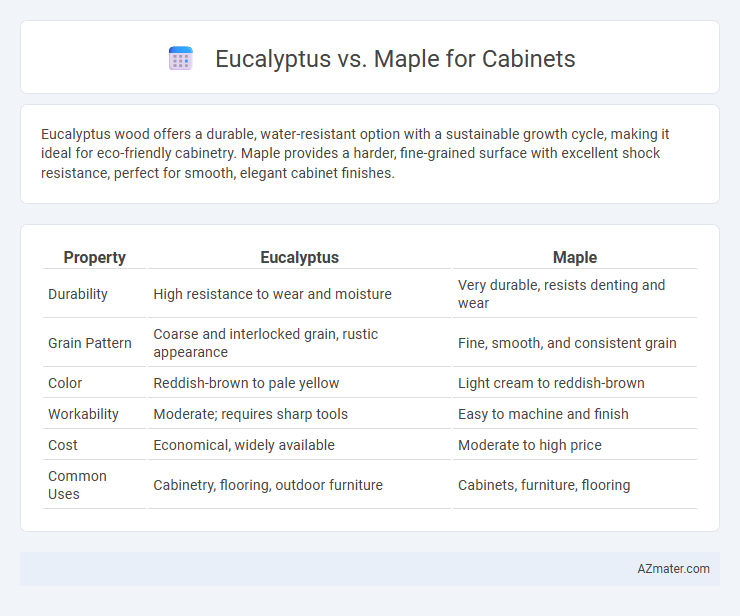Eucalyptus wood offers a durable, water-resistant option with a sustainable growth cycle, making it ideal for eco-friendly cabinetry. Maple provides a harder, fine-grained surface with excellent shock resistance, perfect for smooth, elegant cabinet finishes.
Table of Comparison
| Property | Eucalyptus | Maple |
|---|---|---|
| Durability | High resistance to wear and moisture | Very durable, resists denting and wear |
| Grain Pattern | Coarse and interlocked grain, rustic appearance | Fine, smooth, and consistent grain |
| Color | Reddish-brown to pale yellow | Light cream to reddish-brown |
| Workability | Moderate; requires sharp tools | Easy to machine and finish |
| Cost | Economical, widely available | Moderate to high price |
| Common Uses | Cabinetry, flooring, outdoor furniture | Cabinets, furniture, flooring |
Introduction: Eucalyptus vs Maple Cabinets
Eucalyptus cabinets offer a unique blend of durability and affordability, featuring a dense grain with natural resistance to moisture and pests, making them ideal for humid environments. Maple cabinets, prized for their smooth texture and fine grain, provide a classic, elegant appearance with excellent strength and stability suitable for high-traffic kitchen areas. Both woods present versatile options, but eucalyptus emphasizes sustainability and cost-effectiveness while maple stands out for its refined aesthetics and long-lasting performance.
Overview of Eucalyptus Wood for Cabinets
Eucalyptus wood offers a durable and eco-friendly option for cabinets, known for its tight grain and smooth texture that provides a contemporary aesthetic. Its natural resistance to moisture and decay makes it suitable for kitchen and bathroom cabinetry, while its warm hues range from light amber to rich reddish-brown, enhancing interior design versatility. Eucalyptus is also a fast-growing hardwood, adding to its sustainability appeal compared to traditional options like maple.
Overview of Maple Wood for Cabinets
Maple wood is highly favored for cabinets due to its durability, fine grain, and smooth texture, which allows for a clean and polished finish. Its light, creamy color lends itself well to both modern and traditional cabinet designs, while being resistant to wear and dents ensures long-lasting cabinetry. The hard, dense nature of maple provides excellent strength, making it an ideal choice for high-traffic areas in kitchens and bathrooms.
Appearance and Grain Comparison
Eucalyptus wood showcases a warm, rich amber tone with subtle reddish hues, featuring a tight, interlocking grain that offers a smooth, uniform texture ideal for modern, sleek cabinetry. In contrast, maple displays a lighter, creamy color palette with minimal variation, characterized by a fine, straight grain that produces a consistent and clean look, perfect for traditional and contemporary designs. Both woods provide durability, but eucalyptus's distinctive grain patterns and color variations add a unique rustic charm, while maple's subtle grain and light tones enhance brightness and elegance in cabinet aesthetics.
Durability and Strength
Eucalyptus wood offers high durability and resistance to wear, making it an excellent option for kitchen cabinets exposed to moisture and heavy use. Maple is renowned for its exceptional strength and fine grain, providing sturdy, long-lasting cabinetry with a smooth finish. Both woods deliver reliable performance, but eucalyptus tends to be more moisture-resistant, while maple excels in hardness and impact resistance.
Cost and Availability
Eucalyptus wood is generally more affordable than maple, making it a cost-effective choice for cabinetry projects. While maple is prized for its durability and smooth grain, it tends to be more expensive and less readily available, especially in certain regions. Eucalyptus offers wider availability due to faster growth rates and sustainable harvesting, providing a budget-friendly alternative without compromising strength.
Sustainability and Environmental Impact
Eucalyptus cabinets offer a sustainable choice due to the tree's fast growth rate and ability to be harvested every 10-15 years, reducing deforestation pressure compared to Maple, which takes 80-120 years to mature. Eucalyptus wood also stores more carbon and has a lower environmental footprint in terms of water usage and pesticide application during cultivation. Maple, while durable, often involves longer supply chains and higher energy consumption in processing, which can increase its overall environmental impact compared to more locally sourced eucalyptus options.
Maintenance and Care Requirements
Eucalyptus cabinets require moderate maintenance, benefiting from regular dusting and occasional polishing to maintain their natural luster and prevent drying or cracking. Maple, known for its durability, demands less frequent care but should be cleaned with mild soap and water to avoid damage to its fine grain and finish. Both woods benefit from controlled humidity levels to prevent warping, but eucalyptus's denser fiber structure makes it slightly more resistant to moisture-related issues.
Best Applications and Styles
Eucalyptus cabinets offer a durable and moisture-resistant option, making them ideal for kitchens and bathrooms with high humidity levels, while their natural light color suits modern and rustic styles. Maple cabinets provide a smooth, fine grain and can be stained or painted easily, fitting well with traditional, transitional, and contemporary designs. Both woods support cabinet construction, but eucalyptus excels in longevity and eco-friendliness, whereas maple offers more versatility in finish options.
Choosing the Right Wood for Your Cabinets
Eucalyptus offers exceptional durability and resistance to moisture, making it ideal for kitchen cabinets requiring longevity and easy maintenance. Maple features a smooth, fine grain with a light, uniform color, perfect for achieving a modern, clean aesthetic in cabinetry. When choosing the right wood for your cabinets, consider eucalyptus for resilience and moisture-prone areas, or maple for its classic look and ease of customization with stains and finishes.

Infographic: Eucalyptus vs Maple for Cabinet
 azmater.com
azmater.com